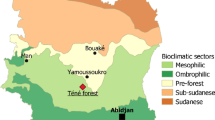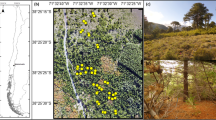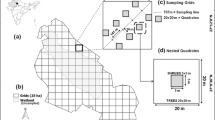Abstract
The last remnants of lowland forests in eastern Africa are biodiversity hotspots as they host a unique set of endemic animal and plant species. However, the diversity of the forests is threatened by man-made disturbances, including the introduction of non-native plant species. Here, we assessed the current extent and drivers of the spread of the invasive neotropical tree, Cedrela odorata L., introduced to Kimboza Forest Reserve in 1957 and 1960. We also assessed the impacts of the invasion on the composition of native tree recruitment (height < 0.5 m). The extent of invasion and drivers was assessed in 107 square plots (10 × 10 m) and 240 subplots (2 × 2 m) distributed systematically throughout the forest. The impact of C. odorata was assessed in 24 paired square sample plots (10 × 10 m) that were established in forest patches invaded and uninvaded by C. odorata. By 2017, adult C. odorata trees (diameter at breast height (DBH) ≥ 10 cm) occurred in 43% of plots and comprised, on average, 32% of the stems of all tree species and 28% of the basal area. The occurrence of C. odorata in the forest was significantly associated with the occurrences of wildfire and illegal logging, and significantly affected the density of native tree recruitments, Sorindeia madagascariensis and Rinorea arborea but did not affect the species diversity. Management actions are needed to reduce the negative impacts of invaded forest patches and prevent the uninvaded forest patches from invasion.






Similar content being viewed by others
Data Availability
The datasets generated during and/or analysed during the current study are enclosed as suplimenatry materials.
References
Bellard C, Genovesi P, Jeschke JM (2016) Global patterns in threats to vertebrates by biological invasions. Proc R Soc B: Biol Scie 283(1823):20152454. https://doi.org/10.1098/rspb.2015.2454
Bellingham PJ, Tanner EVJ, Martin PH, Healey JR, Burge OR (2018) Endemic trees in a tropical biodiversity hotspot imperilled by an invasive tree. Biol Conserv 217:47–53. https://doi.org/10.1016/j.biocon.2017.10.028
Bever JD (2003) Soil community feedback and the coexistence of competitors: conceptual frameworks and empirical tests. New Phytol 157(3):465–473. https://doi.org/10.1046/j.1469-8137.2003.00714.x
Binggeli P (1996) A taxonomic, biogeographical and ecological overview of invasive woody plants. J Veg Sci 7(1):121–124
Binggeli P, Hamilton AC (1993) Biological invasion by Maesopsis eminii in the East Usambara forests, Tanzania. Opera Botanica 121:229–235
Binggeli P, Kilawe CJ (2023) The successful control of the invasive tree, Cedrela odorata L., in the Kirugo Conservation Area in the foothills of the Uluguru Mountains, Tanzania, Miscellaneous Notes & Reports in the Natural History, Ecology and Resources Management, No. 44
Binggeli P (1989) The ecology of Maesopsis invasion and dynamics of the evergreen forest of the East Usambaras, and their implications for forest conservation and forestry practices. Forest conservation in the East Usambara Mountains, Tanzania. World Conservation Union. Gland, Switzerland, pp 269–300
Brown KA, Gurevitch J (2004) Long-term impacts of logging on forest diversity in Madagascar. Proc Natl Acad Sci 101(16):6045–6049
Burgess ND, Clarke GP, Rodgers WA (1998) Coastal forests of eastern Africa: status, endemism patterns and their potential causes. Biol J Linn Soc 64(3):337–367. https://doi.org/10.1111/j.1095-8312.1998.tb00337.x
Burgess ND, Butynski TM, Cordeiro NJ, Doggart NH, Fjeldsa J, Howell KM, Kilahama FB, Loader SP, Lovett JC, Mbilinyi B, Menegon M, Moyer DC, Nashanda E, Perkin A, Rovero F, Stanley WT, Stuart SN (2007) The biological importance of the Eastern Arc Mountains of Tanzania and Kenya. Biol Cons 134:209–231
Butchart SH, Walpole M, Collen B, Van Strien A, Scharlemann JP, Almond RE, Baillie JE, Bomhard B, Brown C, Bruno J (2010) Global biodiversity: indicators of recent declines. Sci 328(5982):1164–1168
Callaway J, Schwab U, Harvima I, Halonen P, Mykkänen O, Hyvönen P, Järvinen T (2005) Efficacy of dietary hempseed oil in patients with atopic dermatitis. J Dermatol Treat 16(2):87–94. https://doi.org/10.1080/09546630510035832
Cheek M, Chipanga H, Darbyshire I, Dorr L (2007) Sterculiaceae Flora of Tropical East Africa. Royal Botanic Gardens, Kew
Cintron BB (1990) Cedrela odorata L. Cedro Hembra, Spanish Cedar, Meliaceae, Mahogany family. Silbéis of North America. Hardwords Agric Handbook 654:250–257
Colon SM, Lugo AE (2006) Recovery of a subtropical dry forest after abandonment of different land uses. Biotropica 38(3):354–364. https://doi.org/10.1111/j.1744-7429.2006.00159.x
Condé TM, Higuchi N, Lima AJN (2019) Illegal selective logging and forest fires in the northern Brazilian Amazon. For 10(1):61. https://doi.org/10.3390/f10010061
Connell JH (1978) Diversity in tropical rain forests and coral reefs: High diversity of trees and corals is maintained only in a nonequilibrium state. Science 199(4335):1302–1310
Dawson W, Burslem DF, Hulme PE (2015) Consistent effects of disturbance and forest edges on the invasion of a continental rain forest by alien plants. Biotropica 47(1):27–37
Dech JP, Robinson LM, Nosko P (2008) Understorey plant community characteristics and natural hardwood regeneration under three partial harvest treatments applied in a northern red oak (Quercus rubra L.) stand in the Great Lakes-St. Lawrence Forest region of Canada. For Ecol Manag 256(4):760–773. https://doi.org/10.1016/j.foreco.2008.05.033
Doggart N, Lovett JC, Mhoro B, Kiure J, Burgess ND (2004) Biodiversity surveys in forest reserves of the Uluguru Mountains. Part II: Descriptions of the biodiversity of individual Forest Reserves. Dar es Salaam: Wildlife Conservation Society of Tanzania, pp 108
Dueñas MA, Hemming DJ, Roberts A, Diaz-Soltero H (2021) The threat of invasive species to IUCN-listed critically endangered species: a systematic review. Gecco 26:e01476. https://doi.org/10.1016/j.gecco.2021.e01476
Dyderski MK, Jagodziński AM (2019) Similar impacts of alien and native tree species on understory light availability in a temperate forest. For 10(11):951. https://doi.org/10.3390/f10110951
Edward E, Munishi PKT, Hulme PE (2009) Relative roles of disturbance and propagule pressure on the invasion of humid tropical forest by Cordia alliodora (Boraginaceae) in Tanzania. Biotropica 41(2):171–178. https://doi.org/10.1111/j.1744-7429.2008.00474.x
Eschen R, Beale T, Bonnin JM, Constantine KL, Duah S, Finch EA, Makale F, Nunda W, Ogunmodede A, Pratt CF, Thompson E, Frances, Witt WA, Taylor B (2021a) Towards estimating the economic cost of invasive alien species to African crop and livestock production. Abstr CABI Agric Biosci 2(1). https://doi.org/10.1186/s43170-021-00038-7
Eschen R, Bekele K, Mbaabu PR, Kilawe CJ, Eckert S (2021b) Prosopis juliflora management and grassland restoration in Baringo County, Kenya: opportunities for soil carbon sequestration and local livelihoods. J Appl Ecol 58(6):1302–1313. https://doi.org/10.1111/1365-2664.13854
Flecks M, Weinsheimer BW, Chenga J, Lötters S, Rödder D (2012) Watching extinction happen: the dramatic population decline of the critically endangered Tanzanian Turquoise Dwarf Gecko, Lygodactylus williamsi. Salamandra 48:12–20
Foxcroft LC, Pyšek P, Richardson DM, Genovesi P (2013) Plant invasions in protected areas: patterns, problems, and challenges. Springer Science and Business Media, UK
Fridley JD, Stachowicz JJ, Naeem S, Sax DF, Seabloom EW, Smith MD, Stohlgren TJ, Tilman D, Holle BV (2007) The invasion paradox: reconciling pattern and process in species invasions. Ecol 88(1):3–17. https://doi.org/10.1890/0012-9658(2007)88[3:TIPRPA]2.0.CO;2
Hall JM, Burgess N, Lovett J, Mbilinyi B, Gereau R (2009) Conservation implications of deforestation across an elevational gradient in the Eastern Arc Mountains, Tanzania. Biol Cons 142:2510–2521
Hobbs RJ, Huenneke LF (1992) Disturbance, diversity, and invasion: implications for conservation. Conserv Biol 6(3):324–337. https://doi.org/10.1046/j.1523-1739.1992.06030324.x
Hulme PE, Burslem DFRP, Dawson W, Edward E, Richard J, Trevelyan R (2013) Aliens in the arc: are invasive trees a threat to the montane forests of East Africa? In: Foxcroft L, Pyšek P, Richardson D, Genovesi P (eds) Plant invasions in protected areas: patterns, problems and challenges. Springer, Netherlands, pp 145–165. https://doi.org/10.1007/978-94-007-7750-7_8
Kacholi DS, Whitbread AM, Worbes M (2015) Diversity, abundance, and structure of tree communities in the Uluguru Forests in the Morogoro region, Tanzania. J For Res 26:557–569. https://doi.org/10.1007/s11676-015-0078-0
Kilawe CJ, Kaaya OE, Kolonel CP, Andrew SM, Mshama CP, Lyimo PJ, Emily CJ (2021) Wildfires in the Eastern Arc Mountains of Tanzania: burned areas, underlying causes and management challenges. Afr J Ecol 59(1):204–215. https://doi.org/10.1111/aje.12805
Kilawe CJ, Mchelu HA, Emily CJ (2022) The impact of the invasive tree Cedrela odorota on the electric Blue Gecko (Lygodactylus williamsi) and its habitat (Pandanus rabaiensis) in Kimboza Forest Reserve, Tanzania. Glob Ecol Conserv 38:e02225. https://doi.org/10.1016/j.gecco.2022.e022255
Langmaier M, Lapin KA (2020) A systematic review of the impact of invasive alien plants on forest regeneration in European temperate forests. Front Plant Sci 11:524969. https://doi.org/10.3389/fpls.2020.524969
Linders TEW, Schaffner U, Eschen R, Abebe A, Choge SK, Nigatu L, Mbaabu PR, Shiferaw H, Allan E (2019) Direct and indirect effects of invasive species: biodiversity loss is a major mechanism by which an invasive tree affects ecosystem functioning. J Ecol 107(6):2660–2672. https://doi.org/10.1111/1365-2745.13268
Lolila NJ, Shirima DD, Mauya EW (2023) Tree species composition along environmental and disturbance gradients in tropical sub-montane forests Tanzania. PLoS ONE 18(3):e0282528. https://doi.org/10.1371/journal.pone.0282528
Madoffe SS (1993) Seasonal abundance and host selection of bark and wood boring beetles in freshly felled Cedrela mexicana, Khaya nyasica and Milicia excelsa in lowland forest in Tanzania. Agricultural University of Norway
Malimbwi R (2002) Inventory Report of Kimboza Forest Reserve in Morogoro, Tanzania, Morogoro-Tanzania. Unpublished Report, p 126
Mazza G, Tricarico E, Genovesi P, Gherardi F (2014) Biological invaders are threats to human health: an overview. Ethol Ecol Evol 26(2–3):112–129. https://doi.org/10.1080/03949370.2013.863225
MEA (2005) Environmental degradation and human well-being: Report of the millennium ecosystem assessment. Popul Dev Rev 31(2):389–398. https://doi.org/10.1111/j.1728-4457.2005.00073.x
Millennium Ecosystem Assessment, MES (2005) Ecosystems and human well-being: synthesis: a report for the millennium ecosystem assessment. Millennium Ecosystem Assessment Series, Island Press
Muellner AN, Pennington TD, Koecke AV, Renner SS (2010) Biogeography of Cedrela (Meliaceae, Sapindales) in Central and South America. Am J Bot 97(3):511–518. https://doi.org/10.3732/ajb.0900229
Mwendwa BA, Kaaya OE, Kilawe CJ, Treydte AC (2020) Spatio-temporal invasion dynamics of Maesopsis eminii in Amani nature forest reserve, Tanzania. For Ecol Manag 465:118102. https://doi.org/10.1016/j.foreco.2020.118102
Newmark WD (2002) Conservation biodiversity in East African forests: a study of the eastern arc mountains. Springer Science and Business Media, Germany
Ngondya IB, Munishi LK (2021) Impact of invasive alien plants Gutenbergia cordifolia and Tagetes minuta on native taxa in the Ngorongoro crater, Tanzania. Sci Afr 13:e00946. https://doi.org/10.1016/j.sciaf.2021.e00946
QGIS Development Team (2020) QGIS Geographic Information System. Open Source Geospatial Foundation Project. http://qgis.osgeo.org
R Core Team (2022) R: A language and environment for statistical computing. R Foundation for Statistical Computing, Vienna, Austria. https://www.R-project.org/
Rodgers WA, Hall JB, Mwasumbi LB, Griffiths CJ (1983) The conservation values and status of Kimboza Forest Reserve, Tanzania. University of Dar Es Salaam, Mimeograph, p 86
Tecco PA, Díaz S, Cabido M, Urcelay C (2010) Functional traits of alien plants across contrasting climatic and land-use regimes: do aliens join the locals or try harder than them? J Ecol 98(1):17–27. https://doi.org/10.1111/j.1365-2745.2009.01592.x
Tilman D, Knops J, Wedin D, Reich P, Ritchie M, Siemann E (1997) The influence of functional diversity and composition on ecosystem processes. Sci 277(5330):1300–1302. https://doi.org/10.1126/science.277.5330.1300
Van der Meersch V, Zo-Bi IC, Amani BH, N’dja JK, N’Guessan AE, Herault B (2021) Causes and consequences of Cedrela odorata invasion in West African semi-deciduous tropical forests. Biol Invasions 23(2):537–552. https://doi.org/10.1007/s10530-020-02381-8
Vilà M, Espinar JL, Hejda M, Hulme PE, Jarošík V, Maron JL, Pergl J, Schaffner U, Sun Y, Pyšek P (2011) Ecological impacts of invasive alien plants: a meta-analysis of their effects on species, communities and ecosystems. Ecol Lett 14(7):702–708. https://doi.org/10.1111/j.1461-0248.2011.01628.x
Wang Y, Naumann U, Wright ST, Warton DI (2012) Mvabund–an R package for model-based analysis of multivariate abundance data. Methods Ecol Evol 3(3):471–474. https://doi.org/10.1111/j.2041-210X.2012.00190.x
Wardle DA, Peltzer DA (2017) Impacts of invasive biota in forest ecosystems in an aboveground–belowground context. Biol Invasions 19(11):3301–3316. https://doi.org/10.1007/s10530-017-1372-x
Werema C (2015) Effects of fire on understorey birds in Kimboza Forest Reserve in the eastern foothills of the Uluguru Mountains, Tanzania. Afr J Ecol 53(3):304–311. https://doi.org/10.1111/aje.12183
Acknowledgements
This work was supported by Rufford Small Grant. Additional funding was obtained from the Zoological Society for the Conservation of Species and Populations. Thanks are due to the Tanzania Forest Service Agency administration in Morogoro Mr. S. Nyabange, F. Msokwa, C. Asenga, G. Paulo, and Mrs. E. Kunambi for the permission to undertake this study in Kimboza Forest Reserve. Thanks to Dr. P. Binggeli, Mr. A.S. Mndolwa, Mr. B. Mhulo, Mr. O. Kaaya, and Mr. S. Dongo, for assisting in field data collection. Many thanks to Dr. P. Binggeli and two anonymous reviewers for commenting on the manuscript.
Funding
The first author received funding from the Rufford Small Grant (Grant No. 157440–1) and The Zoological Society for the Conservation of Species and Populations (Grant No. 3. Lygodactylus williamsi.TZA.2009–4618-A).
Author information
Authors and Affiliations
Corresponding author
Ethics declarations
Conflict of interests
The authors have no relevant financial or non-financial interests to disclose.
Additional information
Publisher's Note
Springer Nature remains neutral with regard to jurisdictional claims in published maps and institutional affiliations.
Supplementary Information
Below is the link to the electronic supplementary material.
Rights and permissions
Springer Nature or its licensor (e.g. a society or other partner) holds exclusive rights to this article under a publishing agreement with the author(s) or other rightsholder(s); author self-archiving of the accepted manuscript version of this article is solely governed by the terms of such publishing agreement and applicable law.
About this article
Cite this article
Kilawe, C.J., Baltazary, I.S., Malila, B.P. et al. Replacement of native trees by the neotropical invasive tree Cedrela odorata L. in the Kimboza Forest Reserve, Tanzania. Biol Invasions 25, 3697–3710 (2023). https://doi.org/10.1007/s10530-023-03136-x
Received:
Accepted:
Published:
Issue Date:
DOI: https://doi.org/10.1007/s10530-023-03136-x




